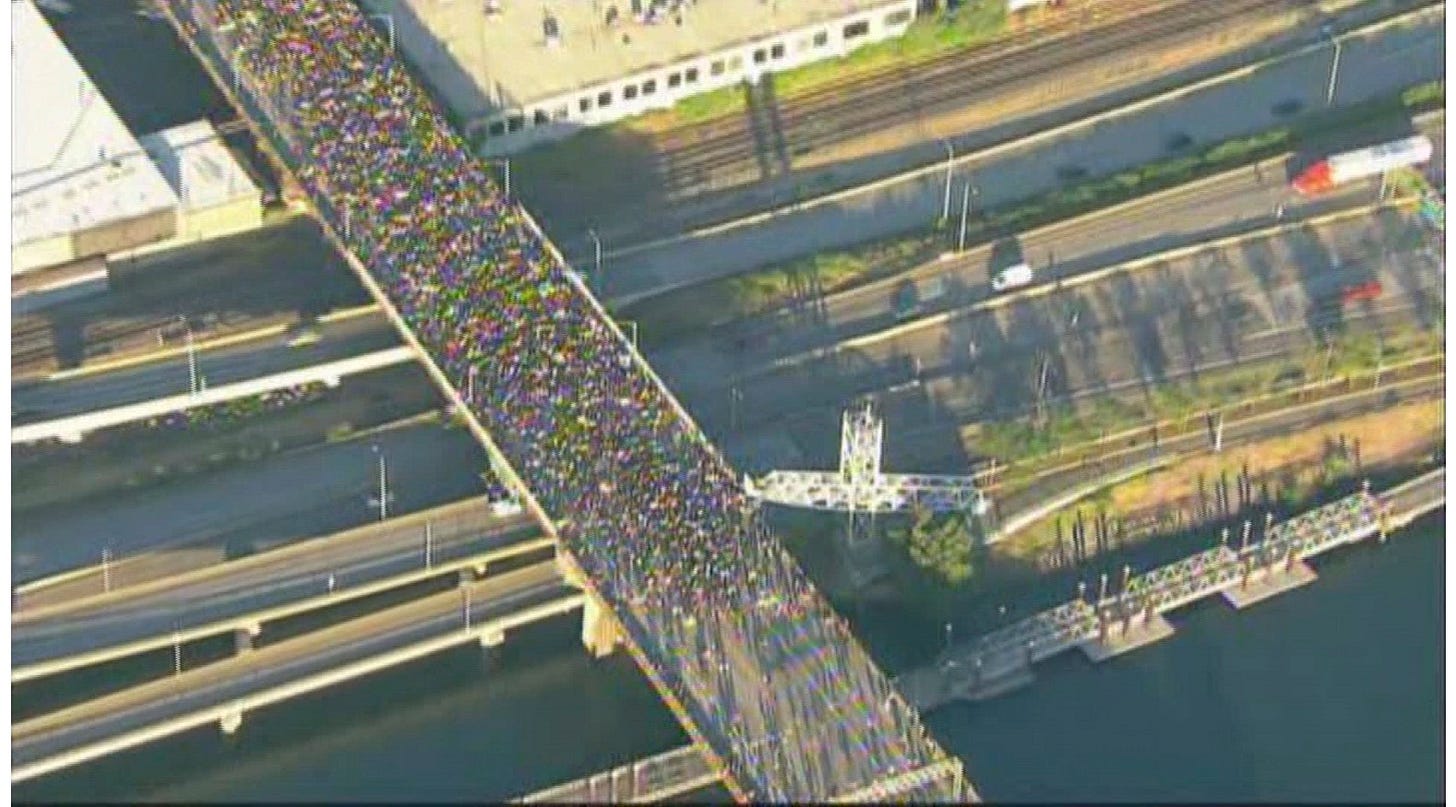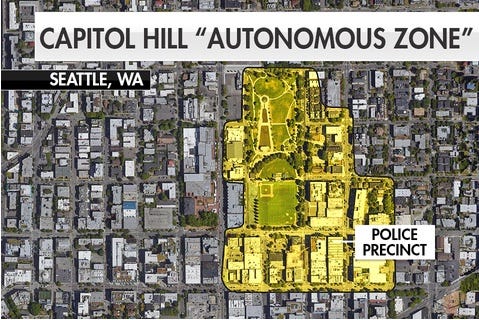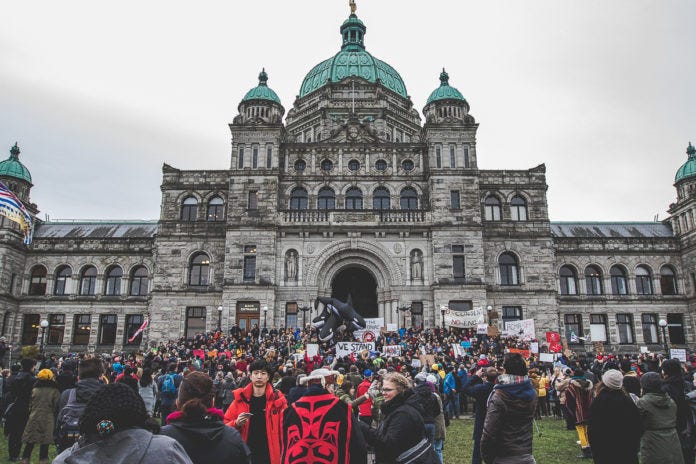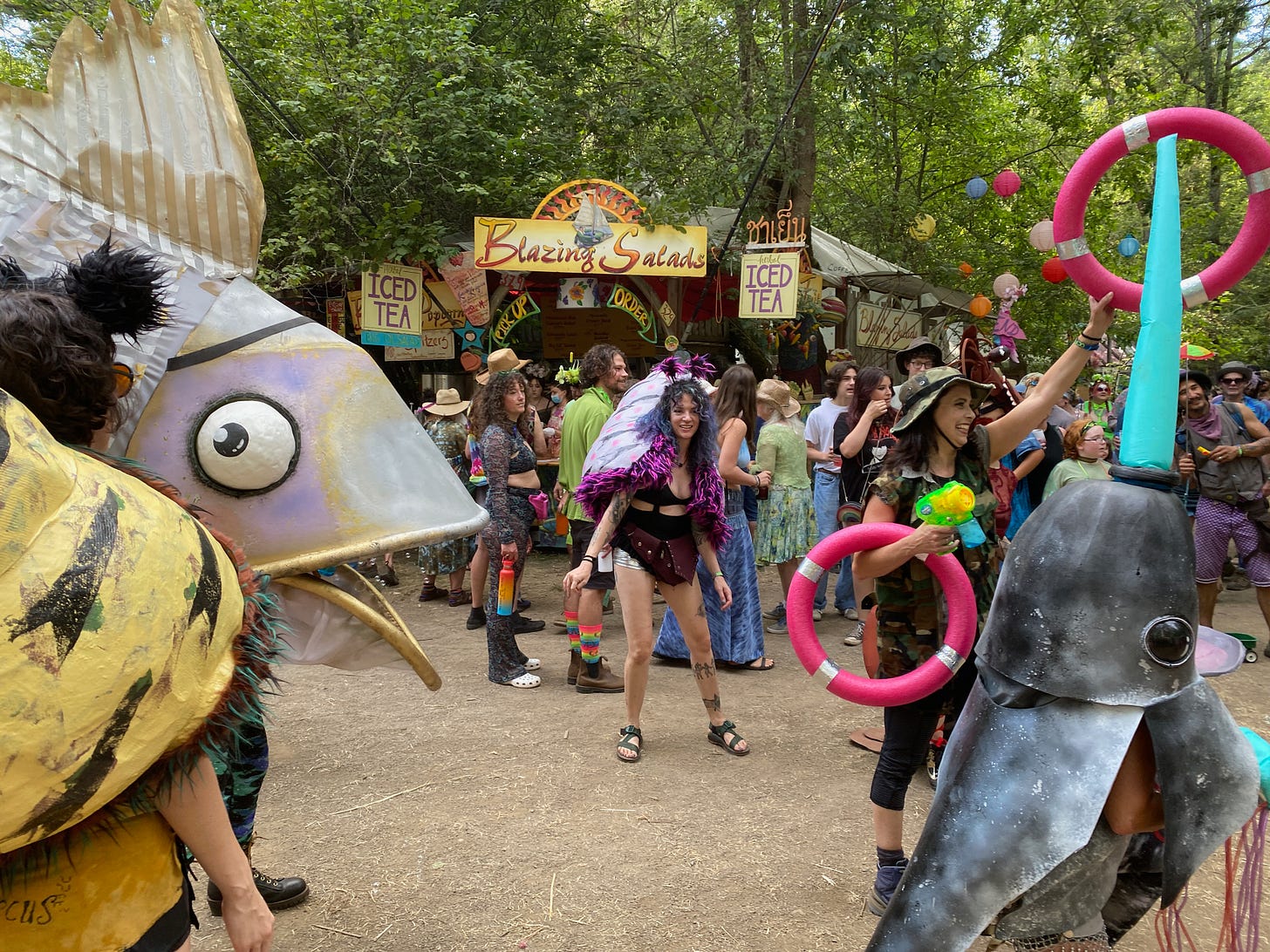Bohemian Cities of the Pacific Northwest
There are millions of people within the Left Coas longing to be free of racism, police repression, and low wages. In this article, we take a look at what's going on north of California.
The Pacific Northwest of the Left Coast is isolated from the rest of America. To the east, there are high mountains, deserts and steppes before one comes to the relatively civilized cities of Chicago and St. Louis.
Between the PacNW and these cities are many nations of the original people of this land, who are still, after 150 years, struggling to exert their sovereignty. The PacNW states of Oregon and Washington have around 3 percent native peoples each, putting them in the top 10 in the US.
This summer, I spent a month visiting this land and checking on the condition of the bohemian cities, and the residents, of Eugene, Portland, Seattle and Victoria.
What makes a bohemian city? Or a Bohemian person, for that matter? The American Heritage Dictionary defines Bohemian as, “A person with artistic or literary interests who disregards conventional standards of behavior.” That’s true, as far as it goes, but there is much more.
Most Bohemians disdain money and traditional lifestyles, preferring instead to follow their own vision, which usually includes an artistic lifestyle. Often, Bohemians will stand up for their rights faster than non-Bohemians. They are found among the staunch supporters of unions, peace, civil and human rights. Most Bohemians care little about economic wealth, but enjoy the company of like-minded people most of all.
We can thank the Sixties for taking Bohemianism a step further. During that unique decade, Bohemians stopped being considered freaks by banding together in certain communities. It was a world-wide phenomena, but it was centered on the Left Coast. Large and small gatherings of Bohemians, also called beats, hippies, heads and, of course, freaks, came into being almost overnight. Many of these communities still exist, although time and Empire have had their effect.
What are they like today? Here’s what I found:
Eugene, Oregon:
This small city, located at the bottom of the Willamette Valley (Portland is at the top) became bohemian in the Sixties. It had a combination of amenities as well as small farms for “back to the land” advocates. In addition, well-known author and “MerryPrankster” Ken Kesey, who lived on a farm outside Eugene played a major role in creating the counterculture. Kesey died in 2001, but his family and co-conspirator, Ken Babbs, carry on his legacy.
A life-sized statue complex of Kesey reading to his three grandchildren can be found in Kesey Square in downtown Eugene. A few blocks away is a statue of the late anti-war Senator Wayne Morse which overlooks the Free Speech area, just across the street from the weekly, “Saturday Market,” where locals sell their handicrafts and other creations. A few blocks away at the bus station, Rosa Parks’ statue sits on a bench waiting for her bus.
While most of Eugene would make any Bohemian feel welcome, one neighborhood, in particular, feels like you are stepping back into the Sixties. That’s The Whiteaker community of brightly colored houses, giant murals, 3-D art pieces, friendly bars and cheap restaurants. The Whiteaker (locals call it The Whit) hood was the original home of unorthodox three-wheel, electric vehicles from Arcimoto.
Also of note is the memorial to the local Japanese population who were put in concentration camps during World War II. It is perhaps the most moving public art work in Eugene, but occupies an out-of-the-way location near the train station.
In addition to the Saturday Market, and a larger, indoor arts and crafts Holiday Market held in December, Eugene counterculture is probably best known for the annual Oregon Country Fair, founded more than fifty years ago. This year saw the return of the event for the first time since 2019 due to the Covid-19 pandemic. On the surface, this year’s Fair was much like past years with seemingly miles of handicrafts in handmade booths, food booths and non-stop music and spoken word performances at nearly 20 stages around the grounds. In all, around 30,000 people attended over three days in July. Unfortunately, this year’s Fair turned out to be a Covid super-spreader. Better luck next year.
The politics of Eugene is dominantly progressive, with large numbers of anarchists, who in the past had united around activist organizations, such as Earth First, Earth Liberation Front and the Black Bloc.
As a result, Eugene is cursed with a massive US Courthouse building in addition to its ample Federal Building. Earthfirsters were convicted here of assaults on a lumber mill, a meat packing plant, and SUVs. At least one ELF member, Daniel McGowan, was sentenced to a prison maximum security facility as an alleged “eco-terrorist,” in 2006. He was released in 2013. In all, 300 federal agents participated in the case. Many Eugene anarchists moved on to Antifa (anti-fascist) work. Antifa is not an organization, but a state of mind.
Portland:
The largest city in Oregon sits on the confluence of the Willamette and Columbia rivers. It has a long history of radical activity with the IWW (Industrial Workers of the World), who in the Pacific NW were itinerate lumberjacks, longshoreman, farm workers, and performed numerous other mainly seasonal jobs.
Two famous Leftists, Elizabeth Gurley Flynn, and John Reed lived in Portland for part of their lives. Flynn, a fiery organizer, was also known as the Rebel Girl, for her role in the struggles of the garment workers. She lived in Portland, with Marie Equi, a fellow Wobbly, feminist, anarchist, and birth control advocate. Her strong belief in justice and freedom of speech led her to become a founder of the American Civil Liberties Union. She also became the top leader of the Communist Party USA in 1961.
John Reed, journalist (Ten Days That Shook the World), and political organizer, was born and grew up in Portland. His reporting took him to Mexico, where he was “embedded” with Pancho Villa’s army. He also covered the Western Front during World War I, and in the highlight of his life, Bolshevik Russia where he ultimately died of typhus. Like Flynn, Reed died in Moscow. Both received massive funeral send-offs in the streets of Moscow.
The traditions begun by the IWW, Reed and Flynn are still strong in Portland. In the 1990s, Portland was dubbed, "Little Beirut" by President George H.W. Bush, for the anger and hatred he generated from the city.
In 2020-21, this city had the most demonstrations for George Floyd, Black Lives Matter, and against police brutality. Portlanders rallied against daily assaults from the police, and often from neo-fascists like the Proud Boys, who flocked to Portland to fight the well-organized protests. Portland has many nicknames, but a new one, that of “Hero City” resounds to all who know about the Summer of 2020.

Taking it a step further, Portland is one of the centers of Cascadia. For many Portlanders, Cascadia is a state of mind within the existing mountains, rivers and trees which stretch from British Columbia to the top edge of California. For others, Cascadia is the name of an independent land, separate and very different from the US. Many people believe sucession is imminent.
Standing up against injustice is obviously a Bohemian trait. In addition, Portland is a haven for the arts and spoken word. Powell’s Bookstore, the pride of Portland, calls itself the largest book shop in the known world. The block-square “mother ship” and numerous satellites make it hard to dispute.
It’s not all politics and struggle for the BOs in PacNW. There’s also a lot of fermenting going on. Portland is the craft beer and cider capital, hosting more than 70 breweries, one of the highest totals in the known world. Talk about creating Bohemian worlds, the late science fiction and fantasy author, Ursula LeGuin, created some of the best from her longtime home in Portland.
In addition, Oregon is the first state in the US to legalize magic mushrooms, sort of. You still have to take your psilocybin in an authorizde location, like a doctor’s office. But it’s a start to letting people be free in their own mind.
Music venues abound, from the 117-year-old White Eagle to the Dandy Warhols’ 10,000 sq. ft. Odditorium. Since Bob Dylan semi-retired and Utah Phillips died, there is little competition with the caliber of folksinger David Rovics, who lives and performs in Portland when he’s not traveling the world.
Where is the Bohemian section of Portland? Two answers occur: 1) it’s everywhere, and 2) it’s a moving target due to gentrification. The best answer right now might be SE Hawthorne, although the industrial area and parts of East Burnside are looking pretty funky.
Seattle:
The largest city in the Pacific NW has quite a history of Bohemianism and rabble rousing. On Feb. 6, 1919, the Great Seattle General Strike began with 65,000 participants. It was the first, and only, general strike in a major US city. There were many reasons for shutting down Seattle, including an ongoing shipyard strike, and the imprisonment of nationally known labor leader, Tom Mooney.
There was also the matter of Vladimir Lenin’s correspondence with Seattle workers in which he asked for their help in getting American troops withdrawn from Russia. At the time, socialism and the Russian revolution had great support among Seattle workers. Did Lenin play a long-distance role in building support for the General Strike?
Through the years, Seattle saw many struggles for civil rights and against racism. A particular hard struggle occurred at Boeing, where the racist founder, Bill Boeing, refused to hire Blacks.
Starting in 1939, a black activist and former local Communist Party leader, Hutchen R. Hutchins, led the campaign to integrate the Boeing Company and the International Association of Machinists (IAM), sadly, went along with Boeing’s anti-Black policies. Hutchins, a reporter at the Northwest Enterprise newspaper, founded the Committee for the Defense of Negro Labor’s Right to Work at the Boeing Airplane Company (CDNL) in 1940. It was not until 1942, with Boeing getting heat from President Roosevelt, that the first Blacks were hired.
Flash forward to 1999 for a meeting of the world’s elite to promote the World Trade Organization (WTO). The first day, Nov. 30 redefined the gathering as the “Battle of Seattle.”
In the last days of the 20th Century there was a growing realization that more than the date was changing. The world elite were uniting and seemed determined to smash the working class. Everyone including Bohemians, labor activists, communists, socialists, anarchists, and even right wingers who were alarmed about the loss of national sovereignty came together in Downtown Seattle.
I had been in Vancouver, British Columbia, for a week of anti-corporate globalism that brought out thousands of Canadians in protest. It was a historic event, until the next week in Seattle, when newspapers around the world were mostly screaming about the threat of revolution. They should have been worried. Upwards of 100,000 demonstrators turned out to say no to the WTO. I joined up with my union’s delegation that had chartered a plane to come from L.A. The total union turnout was so huge we had to meet in a football stadium.
By the time we marched to the WTO meeting area, the Black Bloc, made up of locals and a large crew from Eugene, had already been smashing every window in sight and writing anti-capitalist slogans on all the walls. The crowd blocking the entrance to the WTO’s meeting arena was so large that the delegates could not get in. The proceedings were canceled for the day.
Milling around on the downtown streets that had been “liberated,” I made new friends, like the spiritual teacher, Starhawk, and lots of ordinary people who came out because they had reached the limit of what they could take. It was easy to make friends as we ran from the tear gas and the cops’ batons.
The WTO protests were a great morale boost for the Left. For a time, it felt like we were on our way to a more just society. Then the stolen Presidential election of 2000 happened, followed by the most devastating blow on Sept. 11, 2001. The attack on the Twin Towers (ironically known as the World Trade Center) and the Pentagon opened the door to the Patriotic Act (still in force), arbitrary arrests, government murders without a trial, and spying on all facets of our lives.
In Seattle, the gentrification of the Bohemian district, Capitol Hill continued. It hasn’t been all bad, in 1997 a life-size statue of Seattle local Jimi Hendrix was erected at 1604 Broadway in Capitol Hill. There’s also a Jimi Hendrix park and a Jimi Hendrix museum. Along with the changing scene on Capitol Hill, it’s become the center of LGBTQIA activism.
Grunge music came, in the mid-1980s and went, in the 1990s, at the OK Hotel, and other venues. Grunge was solely a Seattle invention, or reinvention of total bohemian attitudes. According to Jonathan Poneman of Sub Pop Records, “The flannel and ... cracked leatherette coats in the grunge scene were part ... of the Pacific Northwest's thrift-shop esthetic. The music scene inspired role models like Kurt Cobain and bands like Nirvana, Soundgarden, Mudhoney, Pearl Jam, Alice In Chains, whose music is still popular today.
On the bright side, Red Sky Poetry Theater continued on for many years. Anarchist and socialist groups continue their activities, including running book stores, including the still thriving Left Bank Books. Seattle was one of the most active cities in the nation in protesting the murder of George Floyd. Their activity included occupying a section of Capitol Hill for nearly a month in 2020.

The Seattle Hempfest has been advocating the legalization of marijuana since 1991. Nowdays, the June event has grown to 100,000 pot smokers and others, and is held in three waterfront parks.
A high point for the left was the 2013 city council election of socialist Kshama Sawalt. She later won reelection twice plus a recall election. This is in spite of Amazon contributing $1.5 million to her opponent in one of the elections. In addition to Amazon, several of the world’s biggest corporations, including Boeing, Microsoft and Costco, are located in the Seattle area. Seattle is a city of political contrasts. How long can Billionaires and Bullhorns coexist? We may be able to answer that question in the next few years as conditions worsen for working people.
Victoria, British Columbia:
Victoria is known as the “garden city” and it well deserves the name. Every home seems to have a flower garden in its front yard. Nearby, 118-year-old Butchard Gardens is simply stunning. Imagine 55 acres of the most sublime sights and smells in the world. You must travel the 15 miles from downtown Victoria no matter what your state of mind. It’s as close as any of us are going to get to the mythical heaven.
Wandering around Victoria with its still standing architecture from the heyday of the British Empire made me feel like I had just crossed the border from a third-world country. No wonder Victoria has been voted one of the 20 most livable cities in the whole world.
Then there’s the people. Being Canadians, they are polite and friendly. They will go out of their way to make you feel comfortable. How could you not feel comfortable? The city is walkable. There are great restaurants seemingly everywhere. The thrift stores are not hidden in out of the way locations. So many thrift stores do not indicate rampant poverty. Canadians recycle everything including clothes, furniture, etc. Victoria is said to be the witch capital of Canada for its numerous pagan and Wiccan communities. Unfortunately, I was unable to meet any practitioners of the original religion during my stay.

The pleasant way of life I found in Victoria made it difficult to distinguish the Bohemians from the social climbers. Perhaps that’s because, at least in BC, people put family and friends ahead of making a buck. They don’t worry that they will lose their jobs, and hence, their healthcare. In fact, everyone in the country has single-payer health insurance, which is not dependent on their job status, and is minus the big, profit-making insurance corporations running everything.
The Left Behinds
If you think this is a complete survey of Bohemian cities in the Pacific Northwest, you would be wrong. Not mentioned were Vancouver BC, Corvallis Oregon, Ashland Oregon and lots of other small towns north of California. Please write to the Left Coast if you want to nominate one or more places and explain why they qualify as a Bohemian enclave.
Erica Snowlake contributed some of the best parts to this article.




